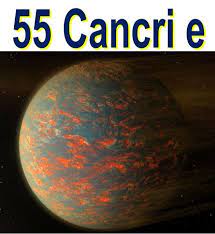Super Earth 55 Cancri e 24
Super Earth 55 Cancri e
A fascinating new frontier in our cosmic investigation, Super Earth 55 Cancri e, has captured the interest of both scientists and aficionados. Located in a variety of settings inside their individual star systems, these exoplanets have masses greater than Earth but smaller than Neptune. Astrobiologists are beginning to recognize super-Earths as important participants in the understanding of life beyond our solar system.
These planets, which are tucked away in the habitable zones of far-off stars, invite us to conduct planetary research in order to unlock their mysteries.
Here, liquid water and possibly even extraterrestrial life could exist.
New technologies like the Kepler telescope have made significant progress toward the goal of finding and studying super-Earths. By scanning large regions of the Milky Way, the telescope has found thousands of potential exoplanet candidates. With seven Earth-sized worlds—three of which orbit within the habitable zone—the TRAPPIST-1 system stands out among these findings as a promising one.
An intriguing subject for further research is Proxima Centauri b, another noteworthy discovery that orbits the star closest to our Sun.
With their compositions similar to those of Earth and their varied temperatures, super-Earths pose a challenge to our knowledge of planetary formation and evolution. Every new discovery that sheds light on these extraterrestrial worlds’ mysteries, from the tidal locking phenomenon to the complexities of their atmospheres, advances our understanding.

With super-Earths enticing us to look farther into space as we stand on the precipice of cosmic discoveries, imaginations of what wonders might be waiting for us beyond our celestial doorstep are aroused.
Follow our Digiknowledge.co.in page for the latest updates about technology, bikes, cars, sports, lifestyle, and many more.
Observations of Super Earth 55 can be detected by Webb’s NIRCam and MIRI detectors
Interesting new information about this exoplanet’s atmosphere composition has been revealed by the data made by Webb’s NIRCam and MIRI detectors.
- These first results provide insight into the peculiarities surrounding this celestial body by pointing to the possibility of an atmosphere that is rich in carbon dioxide (CO2) or carbon monoxide (CO).
- Owing to the tremendous temperatures experienced by the planet due to its close proximity to its parent star, it is thought that the planet’s surface is covered in melted rock.
- This panorama of molten rock suggests a dynamic ecosystem in which gases under the surface may have bubbled up and formed the planet’s atmospheric composition.
- This planet has an extremely complex atmosphere. Due to interactions with its molten surroundings, it is probably complex and varied, providing a tapestry of gases that includes nitrogen, water vapor, sulfur dioxide, and even vaporized rock in addition to carbon monoxide or dioxide.
- Furthermore, because the atmosphere is unstable, brief occurrences like clouds made of tiny lava droplets condensed from atmospheric gases may arise.
- These discoveries provide a clear picture of the varied environments that lie outside of our solar system by highlighting the complex interactions between planetary geology and atmospheric dynamics.
- With every new finding we make while delving into the mysteries of far-off worlds, our curiosity is piqued and our comprehension of the vastness of the universe is expanded.
Some features of Super Earth 55 Cancri e
- Despite having a mass and size similar to our sun, the star Super Earth 55 Cancri has several distinct features of its own, such as being somewhat dimmer and colder. Though it is modest, it gleams brilliantly enough in the deep shadows of a very black sky to be seen with the unaided eye. Its closeness to its circling exoplanet gives the cosmic scene a striking element.
- Super Earth 55 Cancribe appears as a planetary mystery with sizes far larger than Earth. It is a stony colossus in the vastness of space, twice as large as Earth and eight times heavier than our globe.
- As it circles its parent star, Super Earth 55 Cancri, in an unrelenting orbit, this powerful world remains remarkably close—just 1.4 million miles away. Compared to our own planet’s leisurely dance around the Sun, this planet’s narrow orbit necessitates fast revolutions, with a single orbit taking less than eighteen hours.
- The star dominates the skies of this exoplanet, generating a shadow so strong that it surpasses our solar experience. More than 70 times larger than the Sun appears in our own solar system, the star appears enormous in the exoplanet’s sky.
- Furthermore, the occurrence of tidal locking guarantees that the star stays a stationary point in the exoplanet’s sky, a constant light in its enduring dance with its partner in orbit.
- The temperature of Super Earth 55 Cancri e defies predictions, hovering at 2,800 degrees Fahrenheit, despite its very close proximity to its star. Reversing expectations, this very cool temperature suggests the existence of a thin atmosphere that could control the planet’s surface temperatures.
- Another layer of mystery around 55 Cancri e has been added with the discovery of an atmosphere, which has led to conjecture regarding the composition and origins of the gaseous envelope surrounding it.
- According to some theories, the planet’s atmosphere may be nourished by gases rising from a molten lava ocean seething beneath the surface, bringing components from the planet’s flaming depths to the surface.
- An insight into the cosmic ballet of the Super Earth 55 Cancri e system may be gained from this artist’s rendition, which is based on a synthesis of current data collected by the James Webb Space Telescope’s NIRCam and MIRI sensors coupled with older views from beloved telescopes like Hubble and Spitzer.
Although Webb hasn’t actually photographed the exoplanet yet, the combined information from many astronomical devices creates a fascinating story of celestial intrigue that beckons us to reflect on the wonders of far-off worlds and the bright stars that light their paths.
Why is Super Earth 55 Cancri e not habitable?
The planet is too hot for liquid water, another element thought to be necessary for life, therefore according to Dr. Hu, “it cannot be habitable.”
Why does Super Earth 55 Cancri e have a permanent day side and a permanent night side?
The planet is tidally locked, which means that one side of it is constantly facing the star and the other side is always facing away. Like how the moon constantly faces Earth, this also happens. As a result, the planet has two halves: one is continuously dark, and the other is continuously hit by radiation and heat from the star.
Is there water on Super Earth 55 Cancri e?
The atmosphere of 55 Candire was found to contain hydrogen cyanide by NASA’s Hubble Space Telescope, but not water vapor. This implies that hydrogen or helium make up the majority of the atmosphere. Nonetheless, some claim that elements of the planet’s atmosphere, such as oxygen, nitrogen, and water vapor, may also be present in Earth’s atmosphere. Some speculate that a small layer of mineral vapor, such as silicon oxide, or nitrogen or oxygen could make up the planet’s atmosphere.





Nice information
That’s wonderful to hear! I’m glad I could provide some inspiration. Is there anything specific you’re feeling inspired to do or create?